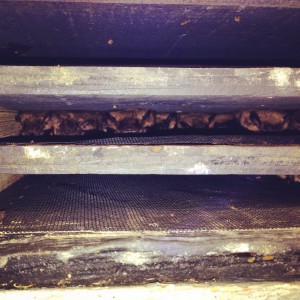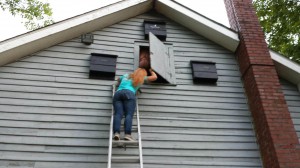Protecting Bats – What is Being Done and How You Can Help!
Hard to believe, but October is already here! And that can only mean one thing — bats! Everyday throughout the month of October, follow CWF on social media and our blog to fly high with these incredible creatures of the night! Each day we will have fun facts, quizzes, and beautiful photos highlighting these amazing animals and the work CWF does to protect them.
Our previous coverage included an overview of bats in New Jersey from our biologist, a look into the threats facing bats today, and a reality check on the myths and legends surrounding bats! Today we share some examples of ways you can get involved in our efforts to save bats in New Jersey. Stay tuned next week to join CWF bat biologist Stephanie Feigin in the field!
Make sure to follow us everyday on Facebook and Twitter and read our blog every Friday for our #31daysofbats!
By Julianne Maksym

With terrifying threats like White Nose Syndrome, bats face a tremendous fight for survival. Populations are declining worldwide at an alarming rate – some species are becoming so rare they are hardly ever seen at all.
Bats need all the help they can get and Conserve Wildlife Foundation (CWF) offers some simple ways to get involved and make a difference:
Building a bat house: This can create a safe and secure home for a colony of bats of up to 80 individuals. These houses provide the opportunity for bats to settle into a new roost before being evicted from a homeowner’s dwelling. The most ideal location to position a bat house is on the side of a building (where bats already roost) or on a pole in open space. The house should be set at a minimum of 12 feet off the ground facing south to southeast with early and direct sunlight. CWF is able to offer free bat houses in cases where bats are being evicted from a building. If interested in setting up a bat house please contact us, as we would like to monitor the process.
Summer Bat Count: During the hot summer months, we ask volunteers to participate in our annual Summer Bat Count. There are a total of four bat counts per summer – two between May 15 and June 21 (before pups can fly) and two more between July 6 and July 31 (when pups are flying and exiting the roost with their mothers). Making sure you do all four bat counts will allow us to best compare data from year to year and between sites. Previous yearly reports and current data sheets can be found at CWF’s ‘Summer Bat Count’ page.

Acoustic surveys: To aid in bat research across New Jersey, CWF purchased two AnaBat SD2 acoustic detectors for the purpose of studying echolocation and general bat behavior. Four bat detectors are now in circulation for use; volunteers now do most of our mobile acoustic surveys. Volunteers are assigned a 10-30 mile driving route in their local area to travel twice each summer after dark. Detectors can be mounted on vehicles and activated while driving at night, making them a pretty quick and easy way to get a lot of information – all without having to catch, hold, or even see a single animal. For more details please contact us, as there is currently a waiting list for the acoustic detectors.
Plant a night garden: Love bats and have a green thumb? Plant a night garden! In these sanctuaries, night-scented flowers are grown to attract bugs such as moths, which in effect provides an ample food source for bats. Plants such as white jasmine and evening primrose and herbs such as mint and lemon balm are great to start with. Plant oak or field maple trees to add some shelter and warmth to your garden. To get started on your green project, check out Back to Nature, an artisanal home and garden store located in Basking Ridge, NJ. *Note: 10% discount for CWF members.
Do not disturb bats during hibernation: A huge way in which to help maintain stable bat populations is to stay away from caves, roosts, or trees during hibernation season. It is important to not disturb a hibernating bat as any disruption to its sleep can result in early awakenings. It is estimated that a bat can burn up to a two weeks worth of fat reserves in each awakening which in turn can severely weaken and/or kill the bat. Whether you are outside hiking or just taking a stroll and encounter a roost, leave quickly and quietly!
 Adopt a Species Program: Interested in adopting a bat? Check out CWF’s Adopt a Species Program for the Indiana Bat. Your symbolic adoption supports our efforts to protect New Jersey’s rarest animals, restore important habitat, and foster pride in New Jersey’s rich wildlife heritage. Adopting a Species also makes a great gift for a friend or loved one. Give the gift that gives twice!
Adopt a Species Program: Interested in adopting a bat? Check out CWF’s Adopt a Species Program for the Indiana Bat. Your symbolic adoption supports our efforts to protect New Jersey’s rarest animals, restore important habitat, and foster pride in New Jersey’s rich wildlife heritage. Adopting a Species also makes a great gift for a friend or loved one. Give the gift that gives twice!
Bats face an ever-present uphill battle due to both natural and unnatural causes. Populations are in desperate need of help! Whether it is building a bat house or a night garden or anything in between, every action you take in supporting these animals means we are one step closer in providing a stable world for them. Join CWF in volunteering your time, educating the public and most importantly, protecting our amazing bats!
Julianne Maksym is a graduate wildlife intern for Conserve Wildlife Foundation of New Jersey
Discover more from Conserve Wildlife Foundation of NJ
Subscribe to get the latest posts sent to your email.
Leave a Comment
Instructions and diagrams for building a bat house might be useful.
If your looking for a high quialty bat house then look no further.
batsbirdsyard.com builds cedar bat houses that are certified by Bat Conservation International.
that bat house sounds cool.my class and I might make one so cool!
cool idea
Comments are closed.